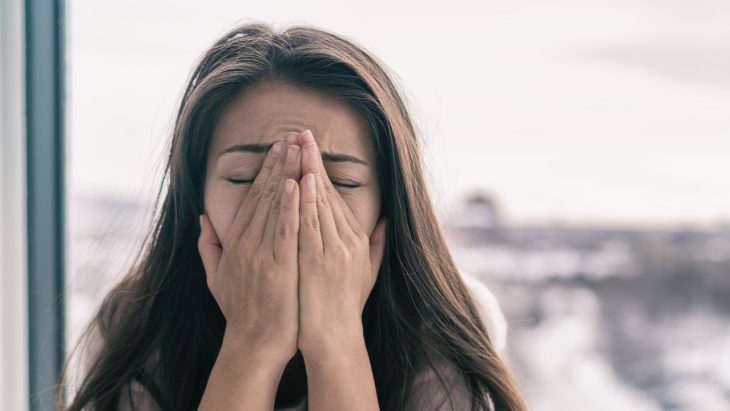5 Most Common Xanax Withdrawal Symptoms
Published: 08/15/2025

Xanax, the brand name of the drug alprazolam, is a short-acting benzodiazepine. When used in small doses and for shorter periods, Xanax can be a beneficial tool in the treatment of anxiety and panic disorder.
However, its use can lead to physical and psychological addiction that produces severe, even life threatening Xanax withdrawal symptoms when discontinued.
Call now to find Xanax detox centers near you!
What is Xanax Withdrawal?
When a person takes Xanax, the body can become physically dependent on the substance. When this happens, if the person stops taking the drug, they experience withdrawal symptoms.
The body is reacting to the absence of the drug, which can cause mild to severe unpleasant physical symptoms, called withdrawal. While these symptoms can vary from person to person, several Xanax withdrawal symptoms are common.
The 5 Most Common Xanax Withdrawal Symptoms
Xanax withdrawal occurs after prolonged use of the drug and can produce both physical and psychological symptoms. The 5 most common Xanax withdrawal symptoms include:
- Anxiety and Rebound Anxiety
- Insomnia
- Flu-like Symptoms
- Depression
- Physical Pain
Anxiety and Rebound Anxiety
One of the earliest symptoms of Xanax withdrawal is anxiety. This typically occurs within six to 12 hours after the last dose and may present with restlessness, racing thoughts, panic attacks and dread.
This can be especially problematic for individuals who were prescribed Xanax for anxiety or panic disorder because rebound anxiety can be worse than the original symptoms.
These withdrawal symptoms usually begin within hours, peak on the second day and should start to resolve within four to five days. On average, rebound anxiety should resolve within about a week.
Insomnia
Individuals in acute Xanax withdrawal often experience trouble falling asleep, frequent waking, restless dreams and night sweats. Xanax withdrawal insomnia can exacerbate anxiety and irritability, starting a cycle that can last beyond the acute withdrawal phase.
You don’t need to detox alone. Call today to get help.
Flu-like Symptoms
Xanax withdrawal can produce symptoms similar to those of the flu. This includes sweating, chills, headache, muscle aches, fatigue, nausea and diarrhea. These generally resolve around days five to seven.
Experiencing these symptoms can lead to dehydration that, when left untreated, may cause dizziness, seizures, kidney failure, low blood pressure, confusion, and in the severest cases, death.
Depression
Individuals who are withdrawing from Xanax often experience symptoms of depression. This Xanax related depression may present as hopelessness, loss of motivation, irritability, and suicidal thoughts.
In some cases, these depression symptoms may improve with the use of selective serotonin reuptake inhibitors or SSRI antidepressants.
Overall these symptoms normally resolve once the brain has had time to rebalance GABA, the brain’s main calming neurotransmitter and serotonin, the feel good transmitter. Both are responsible for mood and stress regulation and overall good mental health.
At times, depressive symptoms can be worsened due to insomnia and PAWS.
PAWS
Some individuals experiencing Xanax withdrawal will develop post acute withdrawal symptoms or PAWS. This occurs when the brain is attempting to heal and regulate certain neurotransmitters, especially GABA.
These symptoms include persistent anxiety or panic, depression or mood swings, irritability, sleep problems, fatigue and cravings and can last for weeks or even months after the acute withdrawal phase.
Physical Pain
During the acute phase of Xanax withdrawal an individual may experience a mix of symptoms that can be quite painful.
These symptoms include head pressure, muscle stiffness or cramps, jaw clenching and back and joint pain. Thankfully, the severity of these symptoms can be lessened through the use of over the counter medications such as ibuprofen or acetaminophen or vitamin supplements such as magnesium glycinate or epsom salt baths.
Other Xanax Withdrawal Symptoms to Expect
In addition to the most common symptoms of Xanax withdrawal, individuals may also experience other symptoms ranging from mild to severe.
These include:
- Headaches
- Light sensitivity
- Blurred vision
- Mood swings
- Loss of appetite
- Tremors
- Seizures
- Hallucinations
- Delirium
- Heart palpitations
- High blood pressure
One way to decrease the severity of withdrawal symptoms is to gradually taper the amount and frequency of the drug. This is especially important with short-acting benzodiazepines due to the intensity and rapid onset of withdrawal symptoms when compared to long-acting benzodiazepines.
The Substance Abuse and Mental Health Services Administration or SAMHSA recommends medically supervised detox as the safest and most effective way to treat acute Xanax withdrawal.
When Do Xanax Withdrawals Begin and Peak?
Xanax withdrawal typically begins within six to 12 hours of the last dose. Individuals can expect to experience the most severe symptoms around days two to four and typically find relief after one to two weeks.
While not everyone will experience PAWS, those who do can experience a longer Xanax withdrawal timeline with symptoms of insomnia, anxiety and depression for weeks or months.
Factors That Affect Withdrawal Severity
Although individuals will experience many of the same Xanax withdrawal symptoms, the severity and duration depends on several factors including:
- Duration of Use
- Using Xanax for longer than three to six weeks may increase the severity of withdrawal symptoms.
- Type of Xanax Used
- Individuals who use immediate release (IR) often have more intense withdrawal symptoms than those who use the extended release (ER) forms.
- Age and General Health
- Older individuals and those with underlying medical conditions may metabolize the medication slower, prolonging withdrawal symptoms.
- Co-use of Other Substances (Polydrug Use)
- Individuals who use Xanax along with other drugs such as alcohol, opioids or other sedatives may experience more severe withdrawal symptoms and also have an increased risk of complications such as seizures, blood pressure issues or PAWS.
- Tapering vs. Cold Turkey
- Individuals who abruptly stop the use of Xanax have an increased risk of severe or life-threatening symptoms including seizures, blood pressure changes or heart palpitations.
- Metabolism Differences (Genetics, Liver Function)
- For some individuals, their genetic make up may increase the severity of Xanax withdrawal symptoms.
- Additionally, individuals with poor liver function have slower drug clearance rates that can prolong the amount of time it takes to fully withdraw.
- Mental Health History
- Co-occurring disorders such as anxiety, depression or PTSD may worsen during the withdrawal phase, increasing the risk of relapse or self injury.
- Past Benzodiazepine Use or Relapse History
- Individuals who have attempted Xanax withdrawal in the past or those who have a history of other benzodiazepine use may experience more severe or prolonged withdrawal symptoms during the acute detox phase.
The Dangers of Stopping Xanax Cold Turkey
Going cold turkey is not only extremely uncomfortable, but it can also lead to serious and even life-threatening symptoms.
- Seizure risk is highest during abrupt withdrawal.
- The risk of seizure during Xanax withdrawal is related to the drug’s impact on neurotransmitters in the brain. This is especially true for its impact on GABA. As a person uses Xanax, the brain decreases the amount of GABA produced.
- When stopped abruptly, the brain does not have the proper amount of GABA needed for calm brain activity, leading to hyperexcitability that can trigger seizure activity.
- Life-threatening symptoms can occur.
- These life threatening symptoms can include seizure activity, blood pressure changes, heart palpitations and changes in mental states such as delirium or hallucinations, leading to injury or suicidal behaviors.
- It’s especially dangerous for long-term or high-dose users.
- Individuals who have used Xanax for longer periods or take it in high doses have a heightened risk of serious withdrawal symptoms. This is due to the changes that Xanax has made in the brain, including the amount of GABA produced.
- Sudden withdrawal does not allow for the brain to adjust, leading to an increased risk of seizure activity, especially grand mal seizures, which can be life-threatening.
Weaning Off Xanax Safely
The safest way to withdraw from Xanax is to taper the dose over a period directed by a medical professional.

One prevailing recommendation is to lower the dose by 10-25% every one to two weeks. This helps to decrease the severity of withdrawal symptoms and allow the brain to adjust the production of neurotransmitters.
Some individuals benefit from switching from fast-acting Xanax to a longer acting benzodiazepine such as diazepam or Valium. This allows for more control by helping to avoid the rapid ups and downs that can come with Xanax use.
As well, long-acting benzodiazepines are taken less frequently and can be tapered in smaller, more controlled steps. This slower, more gradual process allows the brain more time to adjust, making the process safer and much less uncomfortable.
Coping Strategies for Xanax Withdrawals
In addition to a gradual tapering of Xanax doses, several other strategies can help to make the process safer and more tolerable. They include:
- Talk therapy or cognitive behavioral therapy (CBT)
- Sleep hygiene, including darkened rooms and limited screen time
- Hydration and nutrition
- Journaling or support groups
- Medications (antidepressants or anticonvulsants)
- Avoidance of other sedatives including alcohol
When to Seek Help for Xanax Withdrawal
If you experience any of the following Xanax withdrawal symptoms, you should seek help right away.
- Suicidal thoughts
- Hallucinations
- Seizures
- Heart palpitations
Xanax withdrawal can be a serious, even life-threatening process. Individuals should consider a medically supervised detox program for the safest, most supportive experience. Medical and addiction professionals provide around the clock supervision, where early intervention for the most severe symptoms and complications is readily available.
Inpatient detox also provides an environment where outside triggers can be minimized, allowing you to focus on a future where recovery is possible.
Many detox programs also provide addiction education and talk therapies that enable you to develop healthy coping skills and address traumas that may have contributed to your addiction. It’s also a place where you can find peer support that is a critical component of long-term sobriety.
Recovery from Xanax dependence is possible, and asking for help is the first step on the journey toward a brighter future. Websites such as Detox.com provide an online resource where you can find treatment programs filtered by location, levels of care, amenities, programs, insurance and payment programs.
Take the next step to discover Xanax detox and treatment options near you.



